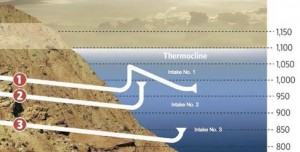Southern Nevada Water Authority crews pulled the end cap off of the agency’s new, deeper Lake Mead intake today, and by this weekend they’ll be pumping water from the new system. This is a major milestone in a system that, when completed, provides critical water management breathing room for the entire Colorado River Basin.
Theorists of “resilience” have adopted ideas from the study of ecology to what they call “social-ecological systems”. One of the critical elements is the idea of “regime shifts” – points in the evolution in the system at which change becomes sudden rather than gradual. A drought-driven forest fire is an example of a “regime shift”, or the sudden dieoff of fish once a river’s water temperature or flow levels cross a critical threshold. The water supply to the greater Las Vegas metro area is one such clearly identifiable scenario where a Colorado River Basin regime shift could happen. As the reservoir from which Las Vegas gets its water, Lake Mead, drops, there reaches a point at reservoir surface elevation 1,000 at which Vegas simply can no longer get water out of the lake. As the lake approaches 1,000, Vegas gets increasingly serious water quality problems, but at 1,000 it’s a city of 2 million people largely without water. “Vegas without water” is the sudden forest fire of the Colorado River Basin. As I’ve argued previously, this has little to do with the use of water by Las Vegas itself, which has become a water conservation model. Agriculture and cities downstream are responsible for most of Lake Mead’s decline. Las Vegas is, in some sense, vulnerable to the water use of others.
“protect elevation 1,000”
This has created an interesting dynamic in Colorado River Basin water management. This high risk scenario – a city of 2 million people losing 90 percent of its water supply – ends up driving everything else, removing management flexibility because of a need to, in the jargon of the water managers, “protect elevation 1,000”. The risk removes resilience by creating an unacceptable risk of regime shift. It also means that those other downstream water users in California and Arizona are vulnerable to Las Vegas’s intake problems, because there’s still a lot of usable water below 1,000 feet that they would not be able to use without drying up Las Vegas in the process.
Opening the new intake, an $817 million project, solves half the problem. But SNWA still needs to finish a pumping plant to take full advantage of it. That $650 million project is projected to be completed by 2020. This is cutting it close. The latest Bureau of Reclamation model runs suggested a one in 25 chance that Lake Mead would fall below elevation 1,025 by 2019, which is pretty risky territory when you’re betting the water supply of a metro area of 2 million people. But imagine the risk scenario if Las Vegas had not been willing to spend the $1.5 billion on the new intake system.

